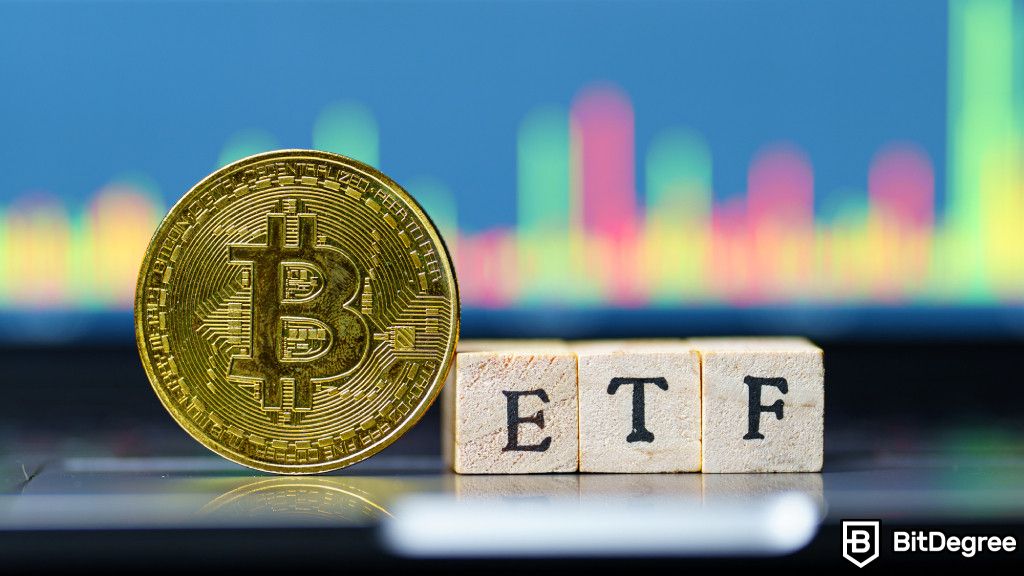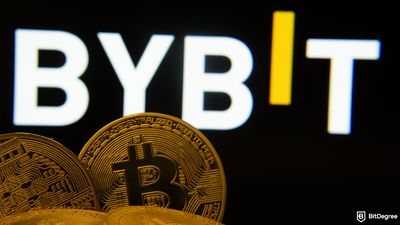Key Takeaways
- Crypto ETFs provide a simplified way to invest in various cryptocurrencies;
- The market has evolved with key players like iShares Bitcoin Trust, Bitwise Bitcoin, and Grayscale Bitcoin Trust, providing varied exposure to digital assets;
- Crypto ETFs offer benefits like diversification and ease of access but also come with risks, such as high volatility and management challenges.
Ace quick missions & earn crypto rewards while gaining real-world Web3 skills. Participate Now ! 🔥
Crypto ETFs are transforming the investment landscape, offering an easy way to tap into digital currencies' high growth potential. These innovative financial instruments combine the ease of traditional ETFs with cryptocurrencies, making them an attractive option for both seasoned investors and newcomers.
A crypto ETF stores various cryptocurrencies in a single investment fund, allowing you to buy shares representing a basket of digital assets. Typically, you need exchanges like Binance, Bybit, or Kraken to buy or trade cryptocurrencies. However, buying these crypto ETFs involves a similar process to purchasing regular stocks or bonds.
In the end, you’ll learn about the evolution of a cryptocurrency ETF, how it works, and discover a popular crypto ETF list. So, let’s explore what exciting possibilities crypto ETFs have to offer!

Did you know?
Subscribe - We publish new crypto explainer videos every week!
What Is Chia? | Crypto Finally Explained


Table of Contents
- 1. What are Crypto ETFs?
- 2. The History of Crypto ETFs
- 3. How a Crypto ETF Works
- 4. What are Popular Crypto ETFs?
- 4.1. iShares Bitcoin Trust (IBIT)
- 4.2. Bitwise Bitcoin (BITB)
- 4.3. Grayscale Bitcoin Trust (GBTC)
- 4.4. Global X Blockchain (BKCH)
- 5. Benefits of Investing in Crypto ETFs
- 5.1. Diversification
- 5.2. Ease of Access
- 5.3. High Liquidity
- 5.4. Potentially Lower Costs
- 6. Risks and Considerations
- 6.1. High Market Volatility
- 6.2. Limited Track Record
- 6.3. Management Risks
- 7. Crypto ETF Investment Strategies
- 8. Conclusions
What are Crypto ETFs?
Let's start with the basics: What is a crypto ETF (Exchange-Traded Fund)? It's an investment fund that lets you invest in various cryptocurrencies without directly owning the digital assets. Unlike traditional ETFs, which track an index, commodity, or collection of assets, a crypto ETF tracks the performance of diversified digital asset portfolios.
Latest Deal Active Right Now:For a limited time only, get Top-rated Ledger bundles for yourself and your loved ones with a 10% Ledger discount code. Take advantage of this valuable Ledger deal NOW!
You might wonder what the difference between crypto ETFs and cryptocurrencies is. Well, it lies in how they’re held and traded.
A crypto ETF functions by holding various digital assets within a fund managed by a professional investment firm. Shares of this fund are then traded on traditional stock exchanges, making it accessible to broader investors. In contrast, cryptocurrencies are individual digital assets like Bitcoin or Ethereum, traded directly on exchanges like Binance and Bybit.
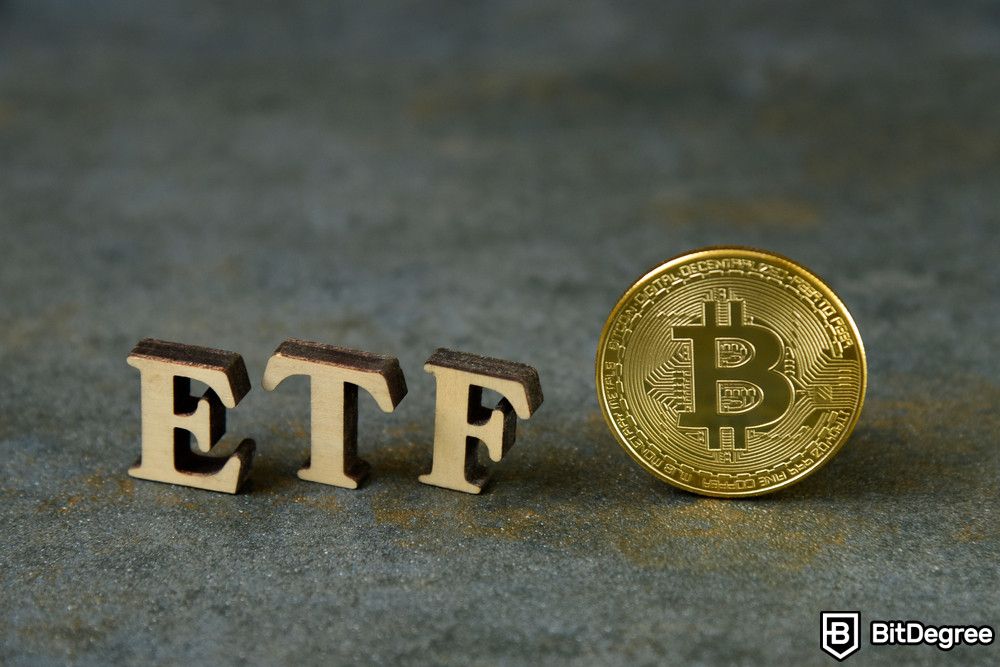
Now that you know what distinguishes crypto ETFs and cryptocurrencies, let’s talk about the differences between crypto ETFs and traditional ETFs:
- Traditional ETFs typically track bonds, stocks, and commodities, while crypto ETFs track digital assets in the crypto industry.
- Due to the nature of cryptocurrencies, which can experience significant price fluctuations, crypto ETFs' risk profile and volatility are generally higher than traditional ETFs.
- The regulatory environment for crypto ETFs is still evolving, leading to potential risks that are less frequent in the traditional ETF space.
- When you buy shares of a crypto ETF, you indirectly own a stake in the underlying cryptocurrencies. This lets you benefit from potential gains without needing individual crypto wallets or trading strategies.
By the way, there are several key players in the crypto ETF market. First, issuers are investment firms or financial institutions that create and manage crypto ETFs. Second, investors and institutional investors buy and sell crypto ETFs. Lastly, government or financial entities oversee the approval and operation of crypto ETFs.
Moreover, there are two main types of crypto ETFs in the market: spot exchange-traded funds and future exchange-traded funds. Let’s discuss them one by one.
Spot Exchange-Traded Funds
Spot crypto ETFs directly hold the underlying cryptocurrency, such as Bitcoin or Ethereum. This means that the price of the ETF will track the cryptocurrency price. Spot ETFs are a good option for those who want to get experience with cryptocurrency without dealing with the complexities of owning and storing themselves.
Future Exchange-Traded Funds
Instead of holding the actual cryptocurrency, future ETFs invest in futures contracts on the digital asset. Futures contracts are agreements to purchase or sell an asset at a certain price on a specific date[1]. They can be a more complex investment than spot ETFs, but they can be a good option for investors looking to speculate on cryptocurrency's future price.
The History of Crypto ETFs
Crypto ETFs have a relatively short but eventful history. So, let’s explore their history, from the first published crypto ETF to recent developments.
Early Beginnings (2015)
The journey of crypto ETFs began in Europe. In 2015, the CoinShares Bitcoin Tracker One became the first publicly traded Bitcoin ETF. This ETF allowed investors to gain exposure to Bitcoin without having to hold the actual cryptocurrency.
Challenges in the US (2013-2020)
In the United States, the road was bumpier. The Winklevoss twins first proposed a Bitcoin ETF in 2013, but the Securities and Exchange Commission (SEC) rejected it due to concerns about market manipulation and investor protection. Over the years, many other proposals were also turned down for similar reasons.
Canadian Breakthrough (2021)
Canada made headlines in February 2021 by launching the Purpose Bitcoin ETF (BTCC) on the Toronto Stock Exchange. This was the first physical Bitcoin ETF in America holding actual Bitcoin, which was a significant step forward for the industry.
A Turning Point (October 2021)
The SEC's stance began to shift in October 2021 when it approved the ProShares Bitcoin Strategy ETF. This ETF was based on Bitcoin futures contracts rather than holding Bitcoin directly, marking a significant milestone in the acceptance of cryptocurrency ETFs in the US.
Major Milestone (January 2024)
A significant development came in January 2024. The SEC approved the first spot cryptocurrency ETFs in the US, which hold actual cryptocurrencies. This approval opened up new opportunities for investors to gain direct exposure to digital assets through traditional financial markets.
Recent Developments (May 2024)
In May 2024, the SEC approved a rule change allowing spot Ether ETFs to be listed and traded. This development further expanded the range of cryptocurrency investment options available in the US.
From this timeline, you can see how crypto ETFs have evolved from their inception in Europe to become a significant part of the investment landscape.
How a Crypto ETF Works
A crypto ETF is structured similarly to a traditional ETF, pooling various cryptocurrencies into a single fund. The fundamental assets typically include digital currencies, such as Bitcoin and Ethereum. The fund manager supervises the ETF portfolio to ensure it aligns with the investment strategy while handling the digital assets' buying, selling, and custody.
Crypto ETFs are traded on traditional exchanges, allowing you to buy and sell shares throughout the trading day. Market makers play a crucial role in this process by providing liquidity and ensuring that buyers and sellers are always available. This helps maintain tight bid-ask spreads and smooth trading.

Net Asset Value (NAV) is primarily used to determine the pricing and valuation of a cryptocurrency ETF. It reflects the total value of the fundamental assets divided by the number of outstanding shares. NAV is calculated daily, but the crypto ETF’s market price can fluctuate throughout the trading day based on supply and demand dynamics.
Managing the custody of digital assets is a critical aspect of crypto ETFs. Fund managers typically use specialized custodial services that employ advanced security measures.
What are Popular Crypto ETFs?
Exploring a popular crypto ETF list can help you decide which suits your investment strategies best. Strong performance, management expertise, and strategic focus are factors that distinguish them. In this section, we’ll explore some of the best crypto ETFs available in the market.
iShares Bitcoin Trust (IBIT)
The first asset worth noting in my crypto ETF list is iShares Bitcoin Trust (IBIT), one of the best crypto ETFs launched by BlackRock in January 2024. Designed to provide direct exposure to Bitcoin, IBIT lets you access Bitcoin through a traditional brokerage account without managing digital wallets or using cryptocurrency exchanges.
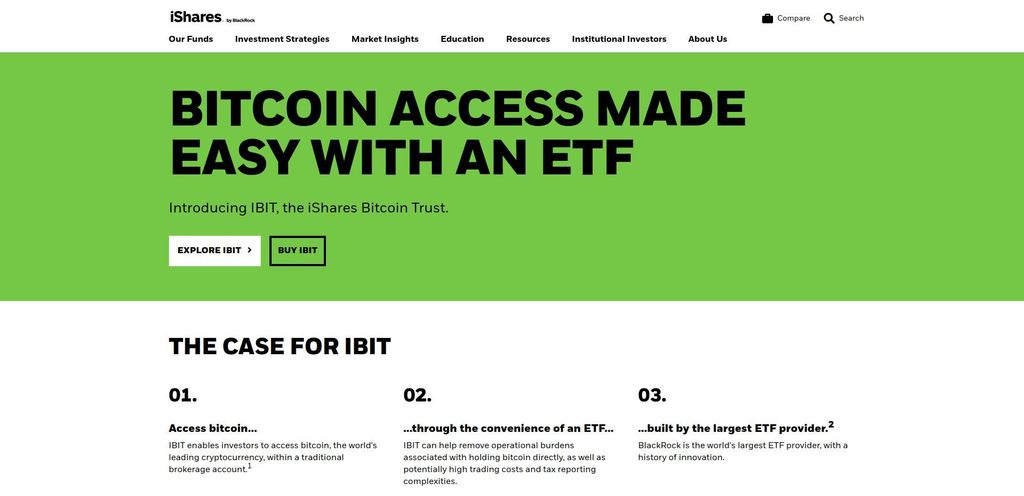
This crypto ETF has quickly gained popularity due to its association with BlackRock, the world’s largest asset manager. The trust benefits from BlackRock’s extensive experience managing ETFs and its strong reputation in the financial industry. The initial promotional period has also made IBIT an attractive option for investors.
IBIT has shown initial solid performance results, reflecting Bitcoin’s price movements. The trust focuses on providing transparent and cost-effective exposure to Bitcoin. The expense ratio of 0.12% is very competitive, making it one of the best crypto ETFs in terms of cost efficiency.
Bitwise Bitcoin (BITB)
Bitwise Bitcoin (BITB) is an exchange-traded fund by Bitwise Asset Management launched in 2024. This ETF holds Bitcoin directly, secured through a multi-layer cold storage wallet, ensuring high levels of security for the underlying assets.
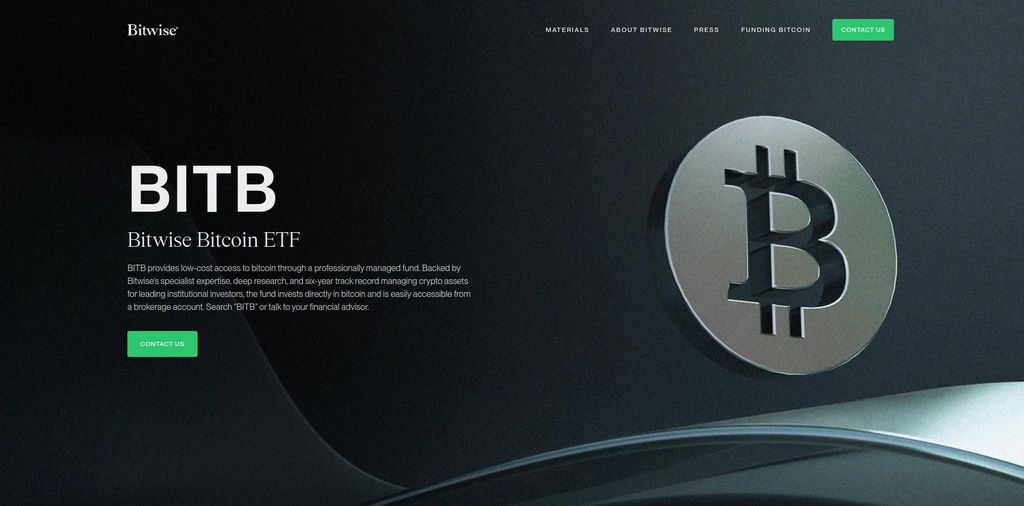
BITB has become one of the best crypto ETFs in the market due to Bitwise’s reputation as a leading crypto asset manager and its competitive fee structure. With a management fee of 0.2%, BITB is one of the lower-cost options among Bitcoin ETFs. Additionally, Bitwise’s long history in managing crypto index funds lends credibility and trust to this ETF.
BITB has demonstrated robust growth since its initial launch. The fund's strategic focus is providing low-cost, secure, and regulated exposure to Bitcoin. This positions BITB as one of the best crypto ETFs, appealing to individual and institutional investors.
Grayscale Bitcoin Trust (GBTC)
Another promising digital asset in my crypto ETF list is Grayscale Bitcoin Trust (GBTC), an investment instrument launched by Grayscale Investments. Initially offered through private placement in 2013, GBTC became publicly traded on the OTC Markets in 2015 before being listed on NYSE Arca in January 2024 as a spot Bitcoin ETF.

GBTC is popular due to its pioneering status and association with Grayscale. The trust has grown significantly over the years, benefiting from Grayscale’s reputation in managing crypto assets.
GBTC's performance is quite noteworthy, as it reflects Bitcoin’s price movements. The trust focuses on passively holding Bitcoin, providing investors with a simple and effective way to track Bitcoin’s market value. Despite its high expense ratio, GBTC’s strategic focus on Bitcoin and well-regulated investment vehicles make it a popular niche market.
Global X Blockchain (BKCH)
Global X Blockchain (BKCH) was launched in July 2021 and is designed to track the Solactive Blockchain Index. This ETF invests in high-ranking companies that benefit from blockchain technology’s adoption and development. BKCH offers investors a diversified approach to investing in this emerging sector.

BKCH has gained popularity due to its strategic focus on blockchain technology. This makes BKCH an interesting option for investors looking to profit from blockchain technology’s potential growth.
Managed by an experienced team, the ETF has a relatively low expense ratio of 0.5%. BKCH’s strategic focus on key players in the blockchain industry contributes to its strong performance as one of the best crypto ETFs.
Benefits of Investing in Crypto ETFs
Crypto funds have become increasingly popular as they offer a balanced approach to cryptocurrency investment. Though, that’s not the only benefit a crypto ETF offers. That said, let’s explore those benefits.
Just remember that any type of investment has risks. Therefore, before making any important investment decisions, it would be best to consult with a financial advisor.

Did you know?
Subscribe - We publish new crypto explainer videos every week!
Crypto Day Trading VS Swapping: What’s More Rewarding? (Animated)


Diversification
The first benefit of buying a crypto ETF is diversification. But what is it? In short, diversification means that even if one cryptocurrency underperforms, the impact on the overall investment is minimized. So, by spreading the investment across multiple digital assets, crypto funds can help mitigate market volatility.
Many crypto ETFs include new or lesser-known cryptocurrencies, giving you access to potential high-growth assets they might overlook. This lets you benefit from emerging trends and innovations within the crypto landscape.
Crypto ETFs can focus on specific sectors or reflect the overall market. For instance, some might concentrate on blockchain technology companies, while others might track the performance of decentralized finance (DeFi) projects. This variety lets you tailor your investments based on your interests and market outlook.
The diversity within a single crypto ETF can also provide insights into which types of digital assets are gaining or losing popularity. By examining the performance of different assets, you can gauge market trends and make more informed decisions. Looking for a comprehensive crypto ETF list can help you identify which funds offer the best exposure.
Ease of Access
Buying a crypto ETF through a regular investment platform is much easier than purchasing individual cryptocurrencies. Instead of dealing with multiple exchanges, wallets, and security measures, you can buy shares of a cryptocurrency ETF just like any traditional stock or bond.
This streamlined process eliminates the need to manage various digital assets directly. As a result, it can be more convenient and less intimidating for those new to the crypto market.

ETFs are a well-known investment option, making it easier for traditional investors to explore cryptocurrencies. Their familiar structure means that even those with limited knowledge of digital currencies can comfortably begin investing. This accessibility is a great advantage, as it lets more people participate in the crypto market’s potential growth.
Crypto funds can be seamlessly added to traditional investment portfolios, letting you mix traditional and digital assets. This integration provides a balanced approach to portfolio management. They can also diversify their portfolios while maintaining a simple investment strategy.
Furthermore, investing in cryptocurrency ETFs can reduce the legal issues tied to direct crypto investments. Regulatory entities typically monitor these ETFs to ensure they meet specific standards and provide a layer of protection. It might help mitigate risks regarding the uncertain regulatory environment surrounding cryptocurrencies.
High Liquidity
With crypto ETFs, you can purchase and sell shares on major exchanges during regular market hours, similar to stocks and bonds. They can benefit from the same liquidity as traditional financial instruments. This accessibility means that you have flexibility and convenience in managing your investments.
While crypto ETFs offer familiar trading experience, you should know the specific ETF structure to understand how closely it tracks the underlying cryptocurrency.
Trading crypto ETFs during exchange hours lets you react more swiftly to market movements than holding individual cryptocurrencies. This can help manage risk associated with short-term price fluctuations. However, it’s important to remember that futures crypto ETFs may not perfectly mirror the underlying crypto’s price.
Frequent trading of a crypto ETF can increase its liquidity, potentially leading to a tighter bid-ask spread and a more accurate price for the ETF itself. That said, most crypto ETFs use futures contracts to track the price, and this structure can introduce tracking errors between the ETF and the actual digital asset’s prices.
Furthermore, the ability to trade crypto ETFs on major exchanges can appeal to large investors who value liquidity. The best crypto ETFs attract significant trading activity, meaning they can handle big buy or sell orders without major price disruptions. This makes crypto ETFs a good choice for those investing in cryptocurrency.
Potentially Lower Costs
Direct cryptocurrency investments come with various costs, such as transaction fees, wallet fees, and potential security expenses. In contrast, crypto ETFs generally have lower management fees.
For example, management fees for crypto can range from 0.4% to 1%. Meanwhile, direct crypto transactions can incur higher costs due to multiple fees associated with buying, selling, and securing assets.

A crypto ETF benefits from bulk transactions and professional management, which can lower transaction costs compared to individual cryptocurrency trades. Bulk transactions let fund managers execute trades at a lower cost per transaction.
Investing in a crypto ETF can also offer tax benefits, often lowering taxes. For instance, these funds might get special tax breaks, like delaying capital gains taxes until they are sold. This greatly reduces tax costs for those seeking a digital currency investment with lower taxes.
Additionally, investing in crypto funds saves time and money when monitoring multiple cryptocurrencies. Fund managers handle the portfolio's selection, diversification, and rebalancing, which can be time-consuming if done individually. This can create a well-managed investment, and you can focus on other financial planning tasks.
Risks and Considerations
While investing in a crypto ETF offers several advantages, you must be aware of the risks and considerations. Understanding these factors is crucial for making informed investment decisions. As with any investment, balancing the rewards with the risks is key to building a successful portfolio.
High Market Volatility
Since cryptocurrencies are the fundamental assets of crypto ETFs, they can cause significant price fluctuations. For example, events like Bitcoin halving (when Bitcoin miner rewards are cut in half) or big market trends can lead to sudden price swings[2]. This volatility translates to crypto ETFs, causing their values to change rapidly and unpredictably.
Changes in investor sentiment can quickly shift market conditions, too. Positive news about cryptocurrency adoption or regulatory approvals can increase prices, while negative news can lead to price declines. These are often rapid and can lead to notable gains or losses within a short period.

Another potential risk is the possibility of sudden regulatory actions. Governments are still developing frameworks for cryptocurrencies, and unexpected regulatory changes can immediately impact the market. Such actions might affect investor confidence and market stability, leading to sudden price movements in crypto ETFs.
Additionally, the unpredictable cryptocurrency prices make strategic planning challenging for investors. Unlike traditional assets, where price movements can be more predictable, factors like market sentiment and trends influence cryptocurrencies. Therefore, you must remain vigilant and adaptable in your investment strategies.
Limited Track Record
The relatively new cryptocurrency market and its limited historical data make forecasting trends and assessing risks particularly challenging. Cryptocurrencies have only existed for over a decade, and their market behavior can be unpredictable. This means there isn’t enough data to predict long-term trends or potential risks accurately.
The short history of crypto ETFs means they haven’t been tested through various economic conditions. Stocks and bonds have decades, even centuries, of performance data across different market cycles. In contrast, crypto ETFs are relatively recent innovations, with most launched in the past few years.
When comparing the performance history of crypto ETFs with stocks or bonds, it’s clear that traditional investments offer more stability and predictability. Stocks and bonds have long track records and are supported by well-established regulatory infrastructures. However, crypto ETFs are still navigating evolving regulations and market acceptance.
Moreover, since crypto ETFs are relatively new, they can confuse new investors. Understanding how these funds work, as well as their underlying assets and specific risks, requires a steep learning curve. For those unfamiliar with cryptocurrency, this can lead to misinformed decisions and potential financial losses.

- Secure and reliable
- Accepts fiat currencies
- Lots of trading options
- Reputable exchange
- Accepts fiat currencies
- Offers various trading options

- Accepts fiat currencies
- Simple to use
- Supports only trusted cryptocurrencies
- A leading cryptocurrency exchange platform
- Best for all type investors
- Accepts fiat currencies

- Beginner-friendly
- Secure
- Decent trading and withdrawal fees
Management Risks
The success of a crypto ETF largely relies on fund managers’ skill in selecting and handling digital assets. Effective fund management involves choosing promising cryptocurrencies and deciding when to buy or sell them. Their expertise can greatly influence a crypto ETF's performance, as they need to navigate the volatile crypto market efficiently.
However, there are risks regarding mismanagement. If fund managers choose the wrong assets or fail to respond to market shifts, it can lead to notable losses. Mismanagement might involve holding underperforming assets for too long or not adjusting the portfolio in response to market changes.

Management fees and expense ratios can also vary greatly among crypto ETFs, affecting the total returns on investment. Higher fees can eat into profits, especially in a volatile market.
Some crypto ETFs have lower management fees, making them more attractive to cost-conscious investors. However, you must compare these costs and understand how they impact net returns.
Moreover, a lack of transparency and varying reporting standards among crypto ETFs can pose risks. You might find obtaining clear information about the ETF’s holdings and strategies challenging. Inconsistent reporting can cloud the actual risk ETF’s profile and performance.
Crypto ETF Investment Strategies
Investing in crypto ETFs requires a carefully planned strategy to navigate the volatile cryptocurrency market effectively. While these investment instruments offer a streamlined way to experience digital currencies, implementing the right strategies can enhance potential returns and mitigate risks. Let’s explore the various approaches for building a robust portfolio.
Diversify Your Crypto Investments
Diversification in crypto ETFs is a crucial strategy for mitigating the risks associated with the volatility of individual cryptocurrencies. Therefore, you can reduce the impact of an underperforming cryptocurrency on their overall portfolio. This approach is valuable in the highly volatile crypto market, where prices fluctuate dramatically in short periods.
Spreading investments across different cryptocurrencies helps balance high potential gains with lower risks. When a portfolio includes a range of digital assets, the good performance of some can make up for the poor performance of others. This helps keep returns steady and lowers the chance of big losses.
For instance, a crypto ETF with well-known cryptocurrencies like Bitcoin, Ethereum, and newer ones can provide a more balanced risk and reward.
You can also spread your investments among crypto ETFs, including those specializing in specific technology sectors. For example, some ETFs focus on blockchain technology companies, while others may concentrate on DeFi projects.
To adopt a diversified investment strategy, you should consider the assets included in the ETFs, their management fees, past performance, and the sectors they focus on. You can create a strong portfolio by choosing different ETFs that span different cryptocurrencies.
Market Timing and Dollar-Cost Averaging
Due to the volatility of the crypto market, predicting the best times to buy or sell is highly challenging and risky. So, what is a strategy that might help you mitigate the impact of this volatility? You can utilize dollar-cost averaging (DCA).
DCA helps reduce the risk of making large investments at unsuitable moments. Instead of investing a hefty sum, those using DCA can fund a fixed amount at regular intervals, regardless of the asset’s price. For instance, you can buy more shares when prices are low and fewer when prices are high to potentially lower the average cost per share.

Set a consistent schedule when using DCA with crypto ETFs, such as monthly or bi-weekly investments. Deciding how much to invest each time depends on your financial situation and investment goals. For example, you can allocate some of your income or savings to this strategy.
Thinking long-term is crucial when applying DCA in volatile markets. This strategy works best over extended periods, benefiting you from the gradual asset appreciation while mitigating risks from short-term price fluctuations. Staying committed to a DCA plan through market ups and downs might help avoid emotional reactions and build a disciplined investing approach.
Research ETF Performance and Management
Researching a crypto ETF’s past performance is key to estimating future returns and assessing risk. Historical data shows how the ETF has handled market changes, which helps you understand its stability and potential gains. Although past results don’t predict future outcomes, they offer valuable insight into the crypto ETF’s performance in different markets.
Skilled managers with a track record of effective strategies can also boost your confidence that the fund will navigate the volatile crypto market well. Therefore, understanding the team’s background and performance history is crucial to help you make informed decisions.
Each crypto ETF follows a specific approach, like tracking an index or focusing on certain sectors. This knowledge can help you see if the ETF’s strategy matches your investment objectives and risk tolerance.
Finally, it’s important to compare a crypto ETF’s performance and fees with similar ones. Therefore, you can have a bigger chance of getting good value. High fees can eat into returns, so choose ETFs offering a competitive edge in performance and cost.
Conclusions
Wrapping up, crypto ETFs offer a simplified way to invest in cryptocurrencies. The funds combine the high growth of digital currencies with the ease of traditional ETFs. IBIT, BITB, GBTC, and BKCH offer various investment options that fit different investor needs and risk levels.
Moreover, crypto exchanges like Binance, Bybit, and Kraken act as the backbone of the crypto ETF ecosystem by providing the underlying assets, liquidity, and price discovery. With robust security and transparency, they help investors, especially beginners, confidently enter their crypto ETF investment journey.
As the cryptocurrency market matures, crypto ETFs are becoming a more appealing investment choice. Spreading out investments and using strategic management can help you better tackle the unpredictable crypto market.
The content published on this website is not aimed to give any kind of financial, investment, trading, or any other form of advice. BitDegree.org does not endorse or suggest you to buy, sell or hold any kind of cryptocurrency. Before making financial investment decisions, do consult your financial advisor.
Scientific References
1. M. Islam, J. Chakraborti: ‘Futures and forward contract as a route of hedging the risk’;
2. J. Chan, S. Phoong, S. Phoong, et al: ‘The Bitcoin Halving Cycle Volatility Dynamics and Safe Haven-Hedge Properties’.

